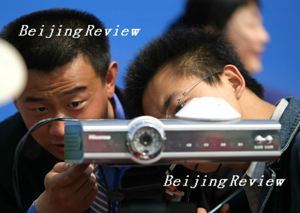|

It’s a scene that has failed to materialize in the past, but companies in China are trying again: sitting in front of the television, the viewer surfs the Internet, buys things from online shops, plays online games and makes video phone calls. The TV will transform into a catch-all information appliance, to be used as computer and telephone.
While the technology is already available in most places, the multitasking TV set hasn’t caught on with consumers. But some Chinese companies think it’s worth another try.
On November 28, 2005, Sichuan-based Changhong, one of China’s largest TV makers, and China Telecom, the country’s largest telecom provider, held a media event in Beijing, Shanghai and Xi’an, simultaneously pushing the button on a joint promotion of TVs that can access the Internet in 17 cities.
The promotion takes advantage of both resources and platforms, with Changhong opening 1,000 shops to sell this kind of TV and China Telecom providing network operation support. Domestic telecom and TV giants joined hands for the first time to promote the information appliance, a groundbreaking action in China’s so-called “3C” industry.
3C stands for computer, communication and consumer electronics. It uses digital information technology to activate any link of the 3C, so that information between computers, communication devices and electronics can be interconnected and exchanged. For the consumer electronics market, this could mean big opportunities.
China Telecom, which has the world’s largest fixed-line telephone network, is now in a strategic transition from basic telecom operator to comprehensive information services provider, and offering value-added telecom services to households and TV users is its major task. China Telecom will join hands with content providers and equipment makers to promote using TVs to access the Internet.
Meanwhile, for Changhong, the world’s second largest TV seller, 3C offers the prospect of expanding into multimedia, value-added areas.
Giants joining hands
Using a TV to surf the Internet isn’t a new concept. At the end of the 1990s, Chinese TV makers, influenced by Microsoft’s Venus project, developed pioneering 3C products such as interactive TVs and web TVs. These products all failed.
But now, 3C products have gained fertile ground in China. Statistics show that in China, there are more than 600 million fixed line telephone subscribers and a home appliance market of 400 million consumers. The number of Internet users has reached 103 million and 53 million access the Internet through broadband. Meanwhile, content on the Internet and TV programs has become increasingly diversified. Equipment and technology of TV production have also improved.
In July 2003, domestic home appliance giants Hisense, TCL and Konka, and IT conglomerates Lenovo and Great Wall Group, set up the Intelligent Grouping and Resources Sharing Standard. The country approved it in June 2005, making it the first technological standard for the 3C industry.
All these factors have contributed to providing the best basic conditions to promote the coming of the 3C era. However, there have been different attitudes toward 3C. Some people still think 3C hasn’t left the laboratory, although the concept has existed in China for five years. This is mainly because it’s still unclear whether consumers, restricted by traditional habits, would actually use TVs to listen to music or use personal computers to receive TV programs. 3C products that don’t fit consumer habits are difficult to sell.
Trans-sector joint sales promoted by Changhong and China Telecom inaugurated a new model for cooperation between TV maker and telecom operator in the information era.
Zhao Yong, Chairman of Changhong’s Board of Directors, said that traditional home appliance makers and consumers are in a loose relationship of buying and selling, which will end when a color TV is sold to a consumer.
With the development of information technology, more and more network operators and content providers are taking the business model of
| 